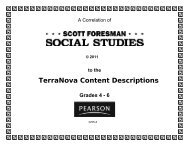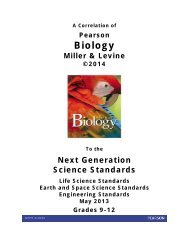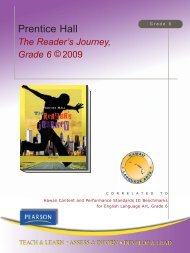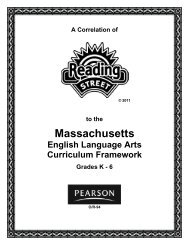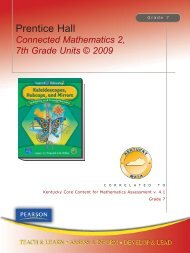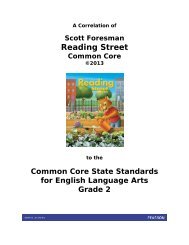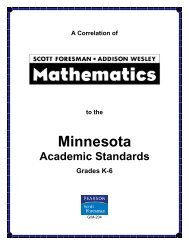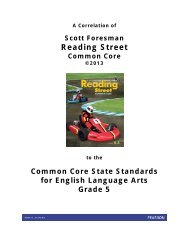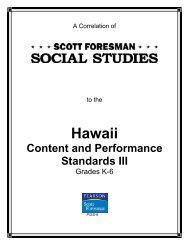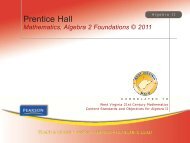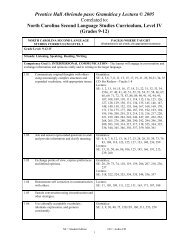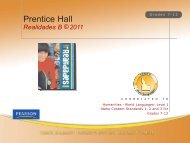A Correlation of<strong>Miller</strong> & <strong>Levine</strong> <strong>Biology</strong>, <strong>Foundation</strong> <strong>Edition</strong>, ©2014to the Next Generation Science Standards, May 2013Grades 9-12Analyzing and Interpreting DataAnalyzing data in 9-12 builds on K-8 experiences andprogresses to introducing more detailed statisticalanalysis, the comparison of data sets for consistency, andthe use of models to generate and analyze data.•Apply concepts of statistics and probability (includingdetermining function fits to data, slope, intercept, andcorrelation coefficient for linear fits) to scientific andengineering questions and problems, using digital toolswhen feasible. (HS-LS3-3)SE: Q1 and Q2 (p. 281); Use ScienceGraphics (p. 284); Chapter Mystery (p. 284)Engaging in Argument from EvidenceEngaging in argument from evidence in 9-12 builds on K-8experiences and progresses to using appropriate andsufficient evidence and scientific reasoning to defend andcritique claims and explanations about the natural anddesigned world(s). Arguments may also come fromcurrent scientific or historical episodes in science.•Make and defend a claim based on evidence about thenatural world that reflects scientific knowledge, andstudent-generated evidence. (HS-LS3-2)SE: Constructed Response, Q1 (p. 422)TE: Active Reading (p. 410)LS3.A: Inheritance of Traits•Each chromosome consists of a single very long DNAmolecule, and each gene on the chromosome is aparticular segment of that DNA. The instructions forforming species’ characteristics are carried in DNA. Allcells in an organism have the same genetic content, butthe genes used (expressed) by the cell may be regulatedin different ways. Not all DNA codes for a protein; somesegments of DNA are involved in regulatory or structuralfunctions, and some have no as-yet known function. (HS-LS3-1)SE/TE: The Double-Helix Model (pp. 294–295); The Genetic Code (pp. 311–312); TheMolecular Basis of Heredity (p. 314);Prokaryotic Gene Regulation (pp. 320–321);Eukaryotic Gene Regulation (pp. 322–323);Genetic Control of Development (pp. 323–324)LS3.B: Variation of Traits•In sexual reproduction, chromosomes can sometimesswap sections during the process of meiosis (cell division),thereby creating new genetic combinations and thus moregenetic variation. Although DNA replication is tightlyregulated and remarkably accurate, errors do occur andresult in mutations, which are also a source of geneticvariation. Environmental factors can also cause mutationsin genes, and viable mutations are inherited. (HS-LS3-2)SE/TE: Phases of Meiosis (pp. 276–277);DNA Replication (pp. 296–299); Types ofMutations (pp. 316–318); Effects ofMutations (pp. 318–319); ChromosomalDisorders (p. 341); Sources of GeneticVariation (p. 407)•Environmental factors also affect expression of traits,and hence affect the probability of occurrences of traits ina population. Thus the variation and distribution of traitsobserved depends on both genetic and environmentalfactors. (HS-LS3-2),(HS-LS3-3)Scale, Proportion, and Quantity•Algebraic thinking is used to examine scientific dataand predict the effect of a change in one variable onanother (e.g., linear growth vs. exponential growth). (HS-LS3-3)LMB: Calculating Haploid and DiploidNumbers (pp. 263–264); Base Percentages(pp. 265–266)---------------------------------------------Connections to Nature of ScienceScience is a Human Endeavor•Technological advances have influenced the progressof science and science has influenced advances intechnology. (HS-LS3-3)SE: Representative Examples: The HumanGenome Project (pp. 344–345); Q3 (p. 347);Changing DNA (pp. 358–360); Health andMedicine (pp. 363–364)•Science and engineering are influenced by society andsociety is influenced by science and engineering. (HS-LS3-3)SE: Unit 4 Project (pp. 259a–259b); Healthand Medicine (pp. 363–364); Ethics andImpacts of Biotechnology (pp. 367–369)TE: Building Scientific Literacy, STEM (p.332a); Transfer Performance Task (p. 346);Active Reading (p. 369)SE/TE: Environmental Influences (p. 324);Genetic Advantages (p. 340)SE = Student <strong>Edition</strong>; TE = Teacher’s <strong>Edition</strong>; LMB = Lab Manual B 14
HS-LS4 Biological Evolution: Unity and DiversityA Correlation of<strong>Miller</strong> & <strong>Levine</strong> <strong>Biology</strong>, <strong>Foundation</strong> <strong>Edition</strong>, ©2014to the Next Generation Science Standards, May 2013Grades 9-12HS-LS4 Biological Evolution: Unity and DiversityStudents who demonstrate understanding can:HS-LS4-1. Communicate scientific information that common ancestry and biological evolution are supported by multiplelines of empirical evidence. [Clarification Statement: Emphasis is on a conceptual understanding of the role each line of evidence has relating to common ancestry andbiological evolution. Examples of evidence could include similarities in DNA sequences, anatomical structures, and order of appearance of structures in embryological development.]MILLER & LEVINE BIOLOGY, <strong>Foundation</strong> <strong>Edition</strong>: Lesson 16.1 (pp. 380–383) describes what Darwin observed during the voyage of theBeagle. Lesson 16.3 (pp. 388–391) presents Darwin’s argument for evolution by natural selection. In Lesson 16.4 (pp. 392–397), studentslearn about other empirical evidence that supports Darwin’s argument. Lesson 17.4 (pp. 417–419) presents the molecular evidence forevolution.Students communicate scientific information about the multiple lines of evidence for biological evolution: Students explain how DNAprovides evidence of common descent (Q16, p. 402). Students explain how fossils support Darwin’s theory of evolution (TE p. 395).HS-LS4-2. Construct an explanation based on evidence that the process of evolution primarily results from four factors: (1)the potential for a species to increase in number, (2) the heritable genetic variation of individuals in a species due tomutation and sexual reproduction, (3) competition for limited resources, and (4) the proliferation of those organisms thatare better able to survive and reproduce in the environment. [Clarification Statement: Emphasis is on using evidence to explain the influence each of thefour factors has on number of organisms, behaviors, morphology, or physiology in terms of ability to compete for limited resources and subsequent survival of individuals andadaptation of species. Examples of evidence could include mathematical models such as simple distribution graphs and proportional reasoning.] [Assessment Boundary: Assessmentdoes not include other mechanisms of evolution, such as genetic drift, gene flow through migration, and co-evolution.]MILLER & LEVINE BIOLOGY, <strong>Foundation</strong> <strong>Edition</strong>: The foundation for understanding the evidence for evolution is laid in Lesson 4.2(pp. 85–86) where the competitive exclusion principle is discussed; in Lessons 5.1 and 5.2 (pp. 108–115) where population growth and limitsto growth are discussed; and in Lesson 13.3 (pp. 316–319) where mutations are discussed. In Lesson 16.3 (pp. 388–391), students areintroduced to the concept of natural selection. In Lesson 17.2 (pp. 409–410), students learn about the impact of genetic variation on naturalselection. In the Chapter 17 Lab, Competing for Resources, students use assorted tools to simulate the competition of birds for seeds.Students construct an explanation based on evidence that evolution results primarily from four factors: Students use experimental datato explain how genetic variation is important in the survival of a species (Q8, p. 397). Students identify heritable variation as a requirementfor natural selection (TE p. 390).HS-LS4-3. Apply concepts of statistics and probability to support explanations that organisms with an advantageousheritable trait tend to increase in proportion to organisms lacking this trait. [Clarification Statement: Emphasis is on analyzing shifts in numericaldistribution of traits and using these shifts as evidence to support explanations.] [Assessment Boundary: Assessment is limited to basic statistical and graphical analysis. Assessmentdoes not include allele frequency calculations.]MILLER & LEVINE BIOLOGY, <strong>Foundation</strong> <strong>Edition</strong>: In Lesson 16.3 (pp. 388–391), students learn how advantageous traits affect survival.In Lesson 16.4 (p. 396), students learn how scientists can observe natural selection in a natural environment.Students apply concepts of statistics and probability to the relationship between advantageous traits and population size: Studentsidentify a trend in bird survival based on beak size (TE p. 397). Students use statistics to explore drug resistance as an advantageous traitfor bacteria (Inquiry into Scientific Thinking, p. 492). Students learn how the presence of mycorrhizae affect the growth and survival ofplants (Lab Manual B, pp. 287–288).HS-LS4-4. Construct an explanation based on evidence for how natural selection leads to adaptation of populations.[Clarification Statement: Emphasis is on using data to provide evidence for how specific biotic and abiotic differences in ecosystems (such as ranges of seasonal temperature, longtermclimate change, acidity, light, geographic barriers, or evolution of other organisms) contribute to a change in gene frequency over time, leading to adaptation of populations.]MILLER & LEVINE BIOLOGY, <strong>Foundation</strong> <strong>Edition</strong>: Lesson 17.1 (pp. 406–408) introduces the concepts of a gene pool and allelefrequency. In Lesson 17.2 (pp. 409–413), students learn how natural selection affects allele frequencies. In Lesson 17.3 (pp. 414–416),students learn how different types of isolation can lead to the adaptation of populations.Students construct an explanation based on evidence for how natural selection leads to adaptation of populations: Students explainhow the evolution of a vascular system affected the ability of plants to survive in various environments (Q2, p. 545). Students explain thebenefit to vines of thigmotropism (Q10, p. 599).SE = Student <strong>Edition</strong>; TE = Teacher’s <strong>Edition</strong>; LMB = Lab Manual B 15



